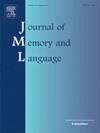Judgments of learning enhance elaborative rather than relational processing: Implications from phonologically related and phonological-semantic mediated pairs
IF 3
1区 心理学
Q1 LINGUISTICS
引用次数: 0
Abstract
Judgment of learning (JOL) reactivity refers to the effect that making JOLs directly impacts subsequent memory performance. One of the most replicated findings in this line of research is that JOLs enhance memory for related word pairs. However, so far, only semantic relatedness has been studied, and many existing theories of JOL reactivity, such as the cue-strengthening hypothesis and the enhanced relational processing account, are heavily dependent on findings generated with semantically related word pairs. The current study used phonologically related pairs instead of semantically related pairs. Specifically, we used rhyme pairs (e.g., fall-tall) in Experiments 1A and 1B and homophone pairs (e.g., coarse-course) in Experiments 2A, 2B, and 2C. A consistent pattern emerged that JOLs did not produce reactivity for phonologically related pairs on associative recall tests, unlike for semantically related pairs. This supports the hypothesis that JOL reactivity reflects an enhancement in elaborative processing, which presumably can involve either item-specific or relational processing that focuses on deeper, semantic content, rather than relational processing that focuses on relational content of any nature. In Experiment 3, we found positive JOL reactivity for phonological-semantic mediated pairs (e.g., coarse-class, where coarse is phonologically related to an unpresented mediator course that is semantically related to class). This, in contrast to the null reactivity for pure phonological relatedness, again supports the necessity of semantic processing in positive JOL reactivity. We discuss how the elaborative processing account offers an opportunity to reconcile existing theoretical explanations and help build a general framework for JOL reactivity.
学习判断促进了精细加工而不是关系加工:来自语音相关和语音语义介导对的启示
学习判断(JOL)反应性是指做出JOL直接影响随后的记忆表现。在这方面的研究中,最被重复的发现之一是,JOLs可以增强对相关单词对的记忆。然而,到目前为止,只有语义相关性得到了研究,许多现有的JOL反应性理论,如线索强化假说和增强的关系处理说,都严重依赖于语义相关词对产生的结果。目前的研究使用语音相关对而不是语义相关对。具体来说,我们在实验1A和1B中使用了押韵对(例如,fall-tall),在实验2A、2B和2C中使用了同音对(例如,rough -course)。一个一致的模式出现,JOLs不产生反应性的语音相关对联想回忆测试,不像语义相关对。这支持了一种假设,即JOL反应性反映了精细化处理的增强,精细化处理可能涉及特定于项目的处理,也可能涉及侧重于更深层次语义内容的关系处理,而不是侧重于任何性质的关系内容的关系处理。在实验3中,我们发现语音-语义中介对的JOL反应性为正(例如,粗类,其中粗类在语音上与未呈现的中介课程相关,而在语义上与类别相关)。这与纯粹语音相关性的零反应性相反,再次支持了积极JOL反应性中语义加工的必要性。我们讨论了精细加工解释如何提供一个调和现有理论解释的机会,并帮助建立JOL反应性的一般框架。
本文章由计算机程序翻译,如有差异,请以英文原文为准。
求助全文
约1分钟内获得全文
求助全文
来源期刊
CiteScore
8.70
自引率
14.00%
发文量
49
审稿时长
12.7 weeks
期刊介绍:
Articles in the Journal of Memory and Language contribute to the formulation of scientific issues and theories in the areas of memory, language comprehension and production, and cognitive processes. Special emphasis is given to research articles that provide new theoretical insights based on a carefully laid empirical foundation. The journal generally favors articles that provide multiple experiments. In addition, significant theoretical papers without new experimental findings may be published.
The Journal of Memory and Language is a valuable tool for cognitive scientists, including psychologists, linguists, and others interested in memory and learning, language, reading, and speech.
Research Areas include:
• Topics that illuminate aspects of memory or language processing
• Linguistics
• Neuropsychology.

 求助内容:
求助内容: 应助结果提醒方式:
应助结果提醒方式:


